
Iceland to Greenland: Total Solar Eclipse (Ultramarine) Itinerary
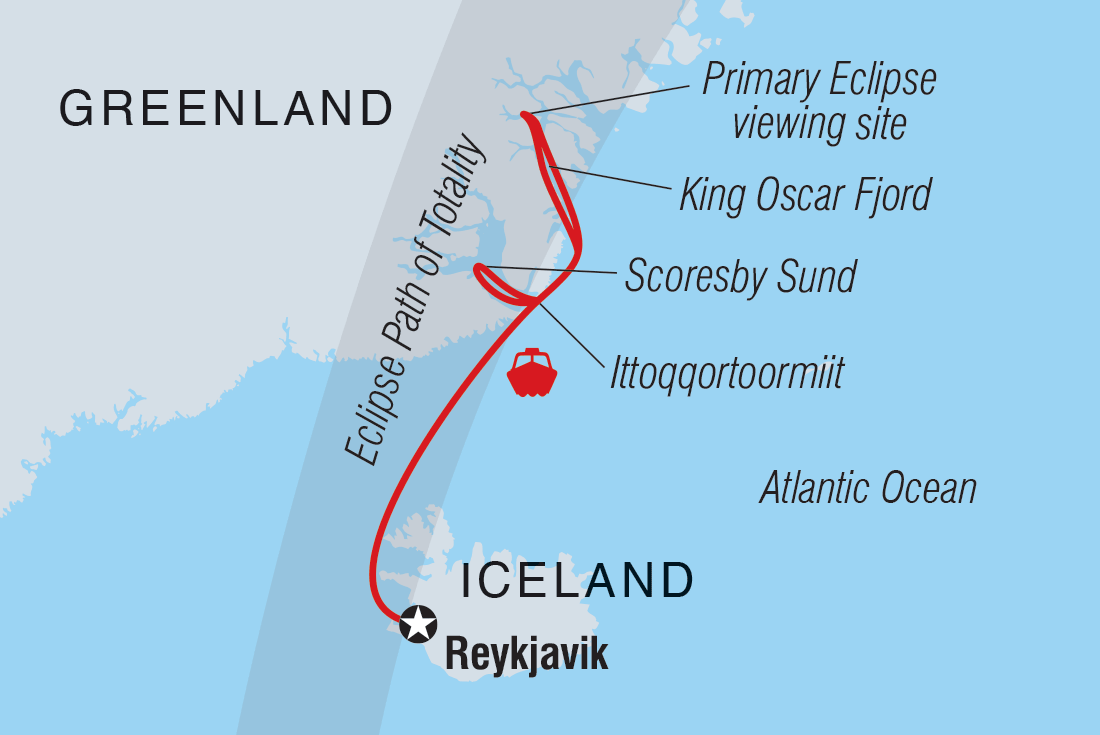


Welcome to Iceland! When you arrive in Reykjavik, Iceland’s capital, make your way to your hotel for a free afternoon and evening. You can arrive at any time, as you have the full day at leisure to settle in and explore the city at your own pace.
After breakfast, you’ll be transferred to your ship – the technologically advanced Ultramarine. Set sail for what’s often referred to as ‘Iceland’s best-kept secret’ – the Westfjords. This rugged peninsula on the remote northwestern tip of Iceland is a region of mountains and fjords. Mountains slope down to the sea, providing plenty of opportunities for landscape photography. Spend the day exploring the fjords and shores of one of Iceland’s oldest regions (home to volcanic rocks dating back 16 million years) by Zodiac and ship, during guided shore landings.
Soak up the views of dramatic cliffs, waterfalls, beaches, rolling hills and high moorlands dotted with rocky outcrops and tiny lakes. You’ll likely spot Icelandic ponies and shaggy sheep grazing the hillsides. A few outposts of civilisation include small fishing communities on the edges of the fjord and along the shores of the Denmark Strait. These modest settlements preserve a maritime heritage that dates back to the heady days of the Viking era. Possible community visits include Vigur Island in Safjaroardjup fjord and the little town of Isafjorour, noted for its wooden houses, fishing boats and hospital-turned-community centre.
As you sail north across the Denmark Strait between Iceland and Greenland, your Expedition Team will prepare you for the exciting adventures ahead, both on and off-ship. The team of polar experts will present on a wide range of topics, including Arctic history, wildlife, geology and climatology. The team will also search for seabirds soaring about the ship and they’ll alert you whenever there’s a whale sighting.
Navigating within the boundaries of the Northeast Greenland National Park – the planet’s largest national park at 972,000 square kilometres – you'll sail into Kangerluk Kong Oscar, also known as King Oscar Fjord, on the northern border of Scoresby Land peninsula. This major fjord system is popular for its famously bright sandstone. When conditions allow, you’ll have the opportunity to hike in Skipperdal Valley, where mineral deposits have painted the hills red and magenta.
As you prepare to position the ship to maximize views of the solar eclipse on Day 7, you’ll also have the opportunity to visit Blomsterbugten (also known as Flower Bay) on Ymer Island. The floral name was chosen by noted archaeologists Gunnar Seidenfaden and Arne Noe-Nygaard during the Lauge Koch expedition in 1929, upon discovering the abundance of specimens for their botanical collection. Blomsterbugten is also home to a little hut known as ‘Varghytten’ (the wolf hut). Built in 1929, the small hut is still used by the Sirius Patrol – a specialised military unit of the Danish Armed Forces. You may also hike to the seldom-visited Noa Lake. There will be a palpable sense of excitement in the air as anticipation builds for the much-awaited eclipse. Behind the scenes, your Expedition Leader, guest eclipse cartographer Michael Zeiler and the Ship Captain will work closely together, monitoring sea and ice conditions and atmospheric forecasts to strategically position the Ultramarine in the best location to maximize your views of the solar eclipse. Relatively few humans get to experience the awe of a polar expedition, but even fewer get to combine the wonders of an Arctic expedition with a solar eclipse viewing.
Expect presentations by your two special guests, eclipse experts David Baron and Michael Zeiler, in the leadup to the August 12 Solar Eclipse. These veteran eclipse enthusiasts will draw on their vast knowledge to ensure you have an eclipse viewing like no other.
On the evening of Day 6, guest expert David Baron will deliver a keynote presentation, ‘Scientific America: The Eclipse that Enlightened a Nation,’ where he’ll delve into the societal impacts of eclipses. Baron will discuss how epic events such as a solar eclipse have spurred societies and specific individuals to achieve scientific greatness.
The Ultramarine will sail further into King Oscar Fjord where the team will identify the most optimal viewing point along the path of totality. With the total eclipse of the sun lasting 2 minutes and 17.2 seconds, this region of the Arctic provides the longest duration of totality along the entire eclipse path. The eclipse will begin at 2:34 pm, totality will begin at 3:34 pm and end at 3:36 pm. The eclipse viewing experience – a duration of 2 hours, 1 minute and 3 seconds – will conclude at 4:35 pm.
This 2026 eclipse is part of Saros series 126, which is a cycle of solar eclipses that repeats approximately every 18 years. It’s worth noting that total solar eclipses in Polar Regions are relatively rare due to the smaller land area and the fact that the sun only illuminates each pole for part of the year. To reiterate, the last total solar eclipse observable north of the Arctic Circle was 2008.
The Expeditions team and guest eclipse experts will continue to research the geography of this region to prepare for the event. Right up until the day of the eclipse itself, the team will study the mountainous terrain, the angles of the sun in the sky, and weather patterns to determine the best possible viewing experience. Your Expedition Leader will outline the day’s agenda in the days and hours leading up to the total eclipse.
As you begin to make your way home (still overwhelmed no doubt by the previous day’s eclipse experience), you’ll visit Scoresby Sound (Scoresby Sund) – a large fjord system on the eastern coast of Greenland. Except for a small population of Inuit at Ittoqqortoormiit, near the mouth of the fjord, Scoresby Sund is largely uninhabited. Warm water polynyas (areas of open water surrounded by sea ice) near the mouth of the fjord support diverse ecosystems of flora and fauna, which is unusual for the Arctic. Numerous mountains, valleys and glaciers line the fjords, giving rise to a spectacular collection of icebergs. Journey through Bjornar (Nannut Qeqertaat), – a group of islands (also known as Bear Islands) located northeast of Milne Land, named during the 1891-92 Den Ostgronlandske (East Greenland) expedition. The collection of 11 main islands fascinates visitors with its maze of channels, steep cliff faces and geology.
While exploring this area, you’ll go on Zodiac cruises and shore visits to several locations. Watch for grazing muskoxen as 40 per cent of the world’s population lives in Northeast Greenland National Park. Sailing through spectacular Scoresby Sund, where many icebergs are birthed, you’ll immediately appreciate why previous visitors have described it as the most beautiful fjord system on the planet. Visit sites such as Vikingbukta, known for its shoreline of basalt columns, and Sydkap, where you can explore the colourful tundra and remains of ancient Thule settlements.
Your Arctic adventure winds down as you sail back across Denmark Strait, southbound this time. Use your remaining time onboard to attend an educational presentation by one of the experts, share your photos, book a massage in Ultramarine’s Tundra Spa, sip an icy cocktail in the bar or ask any questions you may have for our enthusiastic Expedition Team, who will also alert guests of any wildlife sightings.
Disembark in Reykjavik, Iceland’s bustling capital, at the end of your journey. If you have booked post-expedition accommodation, you’ll take a transfer to a central downtown location.
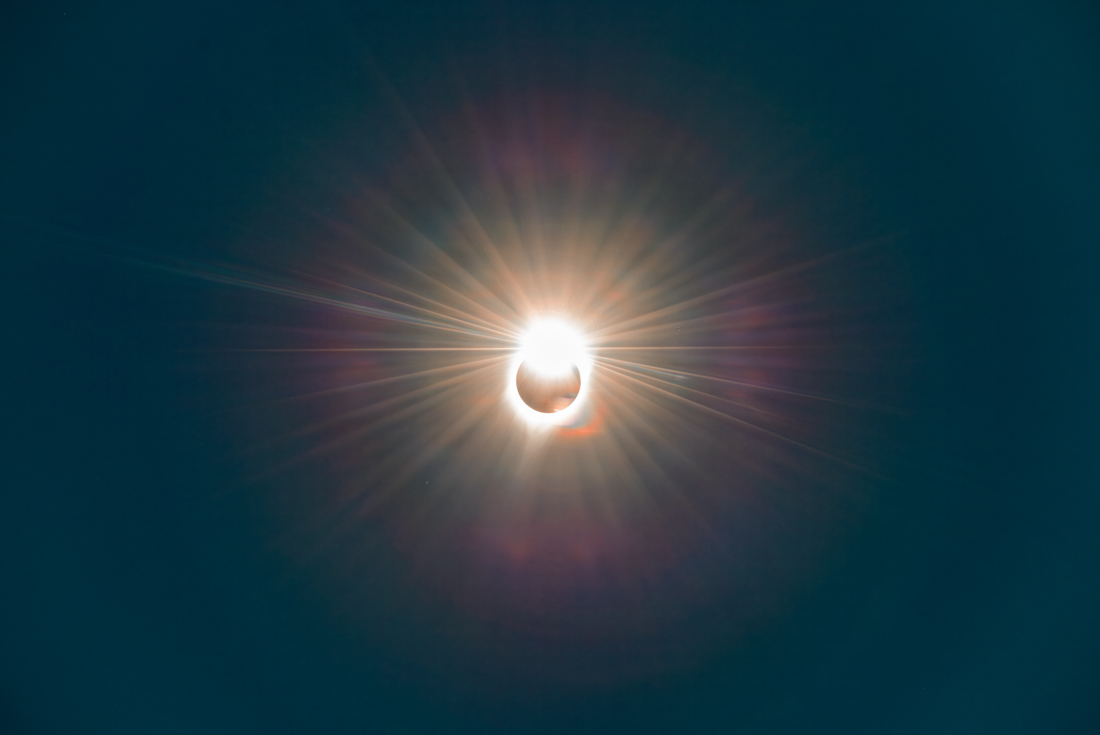
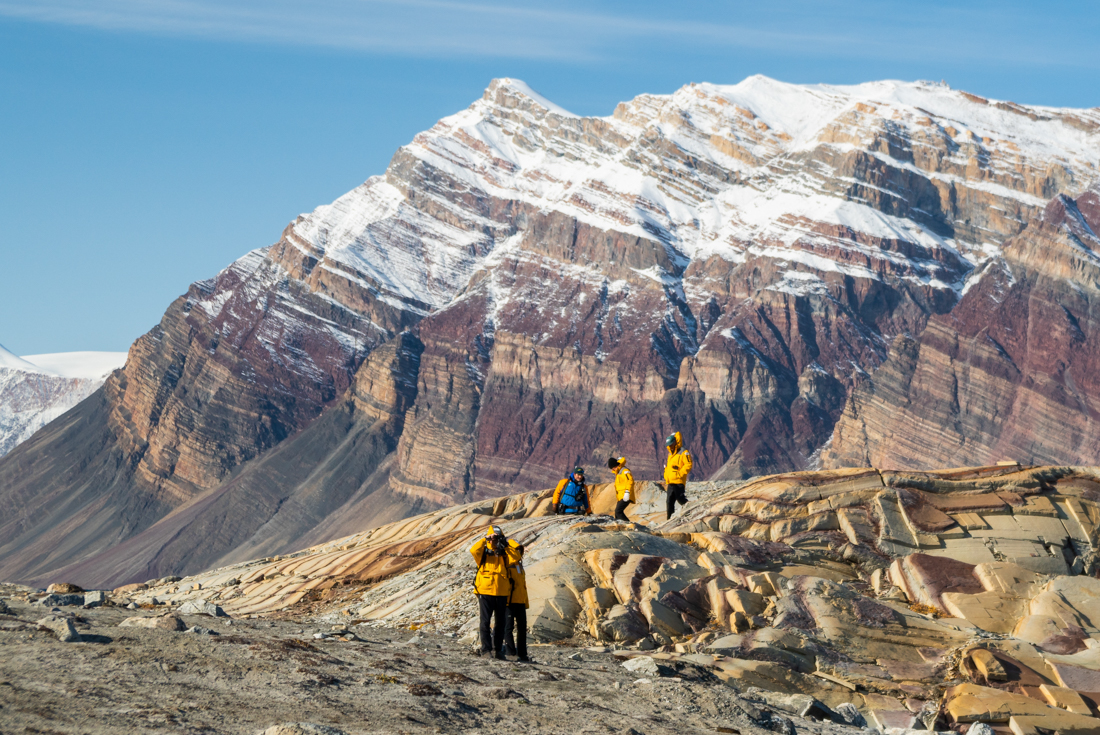
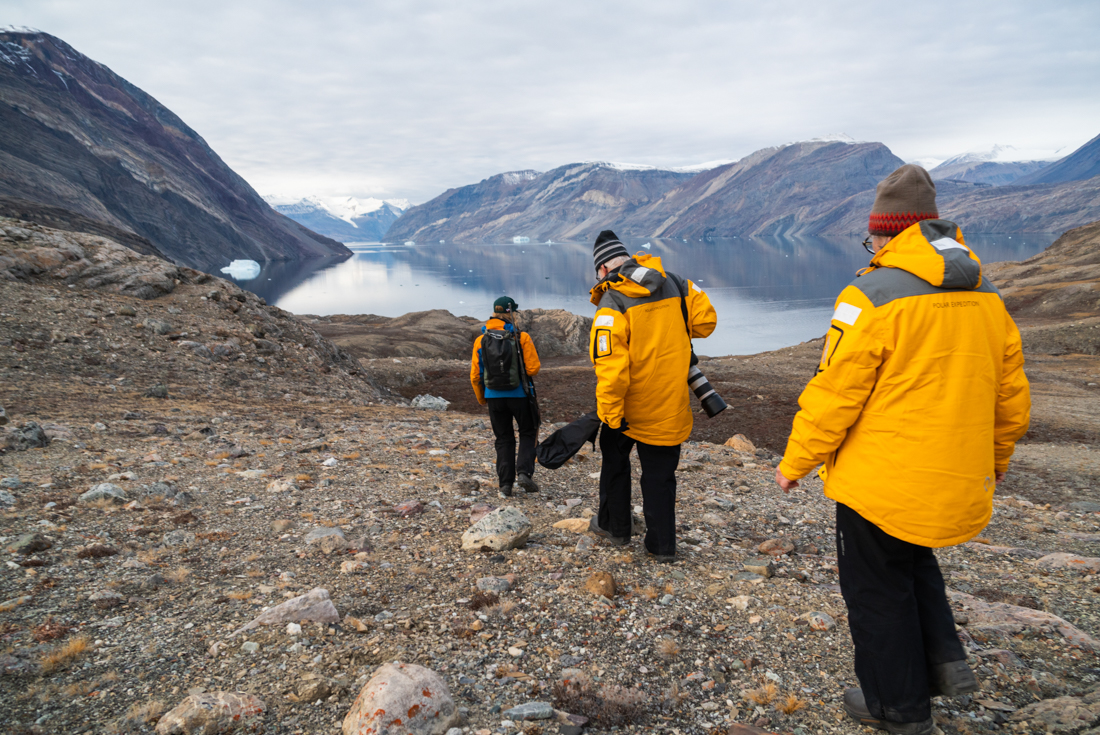

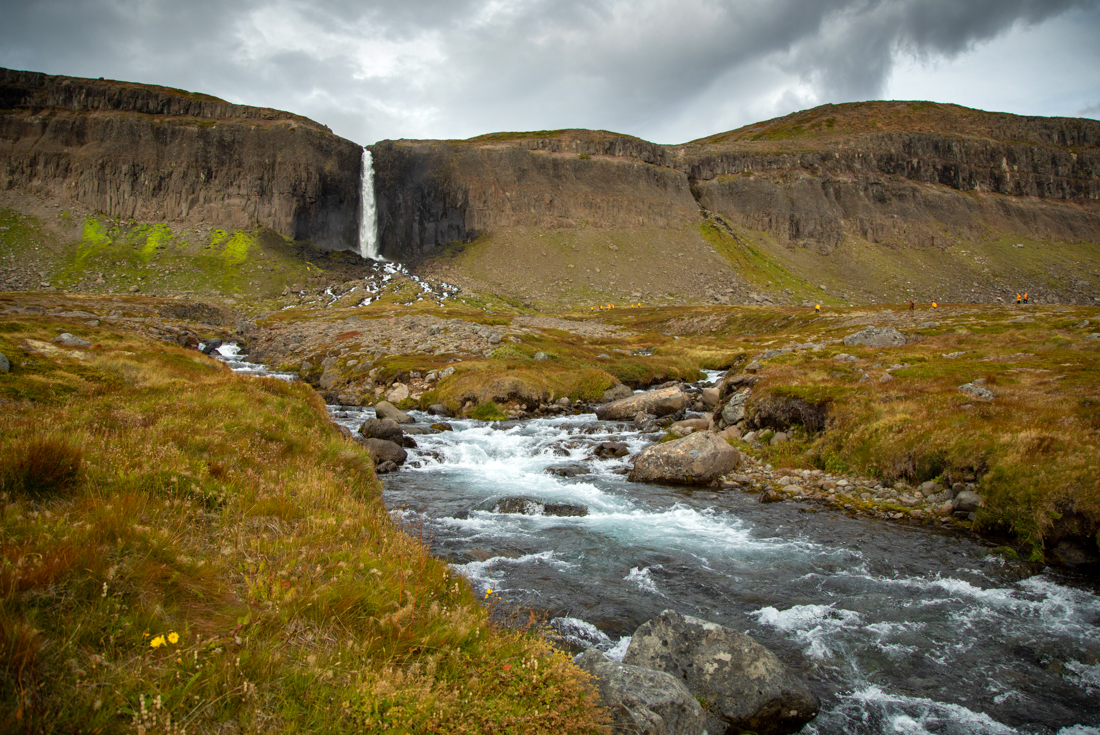
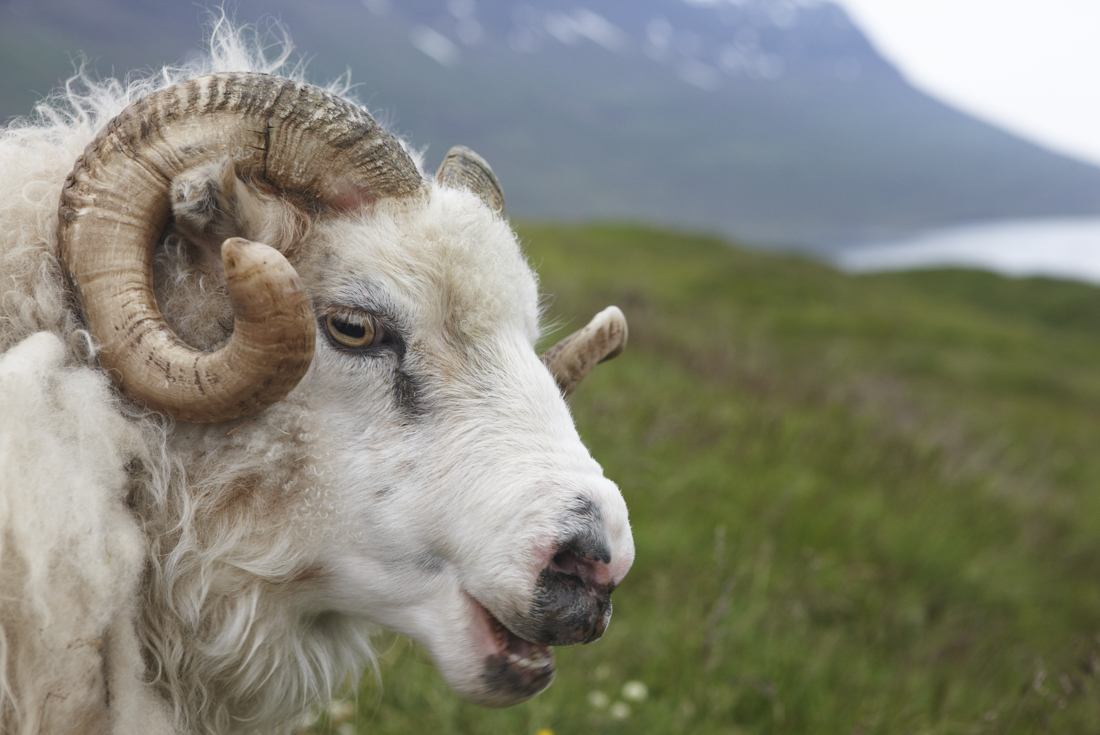
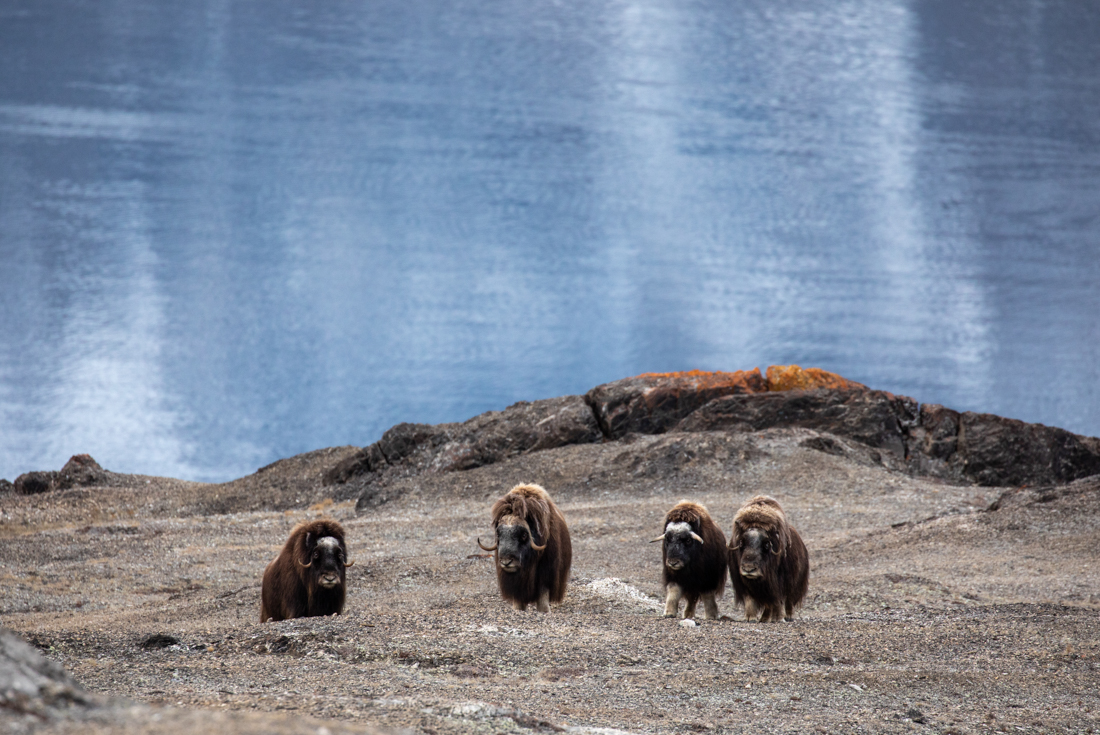

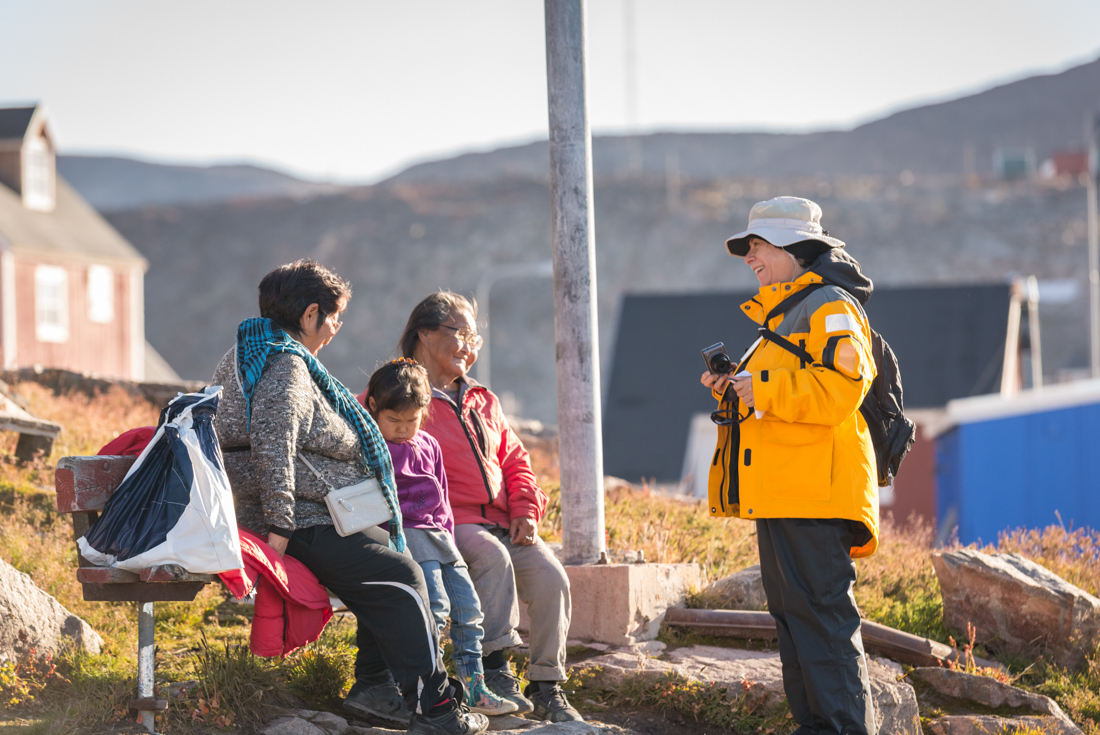
Witness a total solar eclipse from a polar ship in the High Arctic for a truly exceptional once in a lifetime experience like no other.
Gain insight into the cultural and scientific significance of solar eclipses with experts David Baron – a veteran science journalist, broadcaster and umbraphile – and Michael Zeiler – an author, geographer, eclipse cartographer with an asteroid named in his honour.
Heli-flightsee over remote Greenland and explore seldom-visited Westfjords – the hidden gem of west Iceland. You’ll make shore landings by Zodiac and maybe get the opportunity to kayak in the Arctic waters.
Cross the Arctic Circle twice, southbound and northbound and sail across the Denmark Strait.
Witness the wildlife of Northeast Greenland National Park and cruise the 110-km King Oscar Fjord.
Reykjavik, Reykjavik, ICELAND
Reykjavik, Reykjavik, ICELAND
This trip starts and finishes in Reykjavik, Iceland onboard the Ultramarine ship.
Your voyage is operated by our polar partner Quark Expeditions. All accommodation and transfer arrangements as listed in the itinerary are also operated by Quark Expeditions or their local representatives.
BOOKING CONDITIONS
To confirm your reservation, a deposit of 25% (unless indicated otherwise at time of booking) of the total invoice amount is required at time of booking. Balances are due 150 days prior to departure.
Please refer to the "Booking terms and conditions" page on our website for all Quark Expedition terms and conditions. https://www.intrepidtravel.com/booking-intrepid/booking-conditions
ADVENTURE OPTIONS
Kayaking, day paddle and Tundra to Table: Inuit Culinary Experience are optional activities that can booked on this voyage. They must be booked prior to departure and incurs an additional cost. Spaces are limited so please enquire at time of booking. To participate in kayaking, previous, recent experience is essential. In addition, there are other included activities offered on some voyages such as hiking and heli sightseeing. These activities do not need to be booked in advance and no additional cost applies.
While we always endeavour to provide the best possible holiday experience, due to the nature of travel and the areas we visit sometimes things can and do go wrong. Should any issue occur while you are on your trip, it is imperative that you discuss this with your expedition team or local representative straight away so that they can do their best to rectify the problem and save any potential negative impact on the rest of your trip.
You may also choose to provide details in your online feedback, which we ask you to complete within 30 days of the end of your trip. Please do be aware that it is very difficult for us to provide any practical help after the trip is completed, so informing us while still travelling will give us the opportunity to resolve the issue in real-time.
For general enquiries or questions about your booking, please contact your agent or adventure specialist, or visit us at http://www.intrepidtravel.com/contact-us
In case of a genuine crisis or emergency, you can reach our local operator on the number below., Quark Expeditions: +1 647 449 5303
As you’d expect, temperatures in the Arctic are very cold. A warm parka will be provided along with waterproof boots and unlimited hot drinks, but you should also bring base layers and lots of warm clothing. Please see the Essential Trip Information's 'Packing' section., Weather depending, you will be making regular excursions in a Zodiac boat to explore the local area and look for wildlife. It can get very cold and wet on the Zodiac, so make sure you are dressed appropriately and that you keep your camera safe and dry. Sturdy sea legs are needed as you make wet and dry landings from the boat, and on steep terrain, snow and other uneven surfaces. Some ships have a lot of stairs, so please hold on to the handrails if the seas are rough., The weather plays a pivotal part in this adventure and although there’s an itinerary in place, there are no guarantees that you’ll be able to do everything that is planned for. Flexibility and openness to embracing the unexpected are important in expedition travel, especially to such a remote area.
Witness a total solar eclipse from a polar ship in the High Arctic for a truly exceptional once in a lifetime experience like no other., Gain insight into the cultural and scientific significance of solar eclipses with experts David Baron – a veteran science journalist, broadcaster and umbraphile – and Michael Zeiler – an author, geographer, eclipse cartographer with an asteroid named in his honour., Heli-flightsee over remote Greenland and explore seldom-visited Westfjords – the hidden gem of west Iceland. You’ll make shore landings by Zodiac and maybe get the opportunity to kayak in the Arctic waters., Cross the Arctic Circle twice, southbound and northbound and sail across the Denmark Strait., Witness the wildlife of Northeast Greenland National Park and cruise the 110-km King Oscar Fjord.
Your voyage will be led by an experienced Expedition Leader. In addition, a number of experts will be on board to add knowledge of their field to your experience. This will include a Marine Biologist, Ornithologist, Glaciologist or Geologist, Polar Historian, Kayaking guide and Naturalist guides. Voyages offering other adventure activities will have additional specialist guides on board.
Safety is paramount on an Intrepid voyage. Due to new International Security Regulations, you will not be able to approach the ship on your own. You will have to arrive with the rest of the group, accompanied by a Quark representative. Full details of embarkation/disembarkation procedures will be supplied with your final documentation. On board you will be asked to participate in the obligatory lifeboat drill. We will also conduct important briefings on landing procedures and Zodiac operations.
Travelling in the Arctic, encounters with Polar Bears are not uncommon in some areas (and one of the best reasons to go there). You will be given a briefing on Polar Bear safety on board the ship before your first shore landing. Your guides will carry fire arms and bear deterrents on all excursions. Always follow the instructions of your guide while on shore.
All ships operating in Polar waters must comply with a variety of regulations, codes and industry standards. All our ships adhere to regulations set by IMO (International Maritime Organisation) including ISM Code (Safety Management System), ISPS Code (for ship and port security), SOLAS (Safety of Life at Sea) and MARPOL (Maritime Pollution Prevention). In addition, Quark Expeditions is a full member of IAATO (International Association of Antarctic Tour Operators) and a full member of AECO (Association of Arctic Expedition Cruise Operators).
Quark Expeditions have also been externally audited for its' health and safety programme and have been awarded the British Standard BS8848
PASSPORT
You’ll need a valid passport to travel internationally and most countries require your passport to have a minimum of 6 months validity, so remember to check the expiry date.
We need your passport information to get everything ready for your trip so it’s important that the information on your booking matches your passport exactly. Please take care to provide the correct details. We recommend carrying a copy of the photo page of your passport while travelling and leaving a copy at home with family or friends.
VISAS & ENTRY REQUIREMENTS
Many countries require a visa and obtaining the correct visa for your trip and any countries you may transit through is your responsibility. We recommend you check your visa requirements as soon as you have booked your trip. This will ensure you have time to prepare your documents and for your visa application to be processed. You can check the entry requirements for your nationality on your government's foreign travel advisories, consular websites or on our page here: www.intrepidtravel.com/visa-entry-requirements
Information not available.
Validity: 06 Aug 2026 to 18 Aug 2026
Vaccination requirements do change, but generally you do not need vaccinations for this voyage but some may be required or recommended for countries you are visiting enroute to the Arctic.
It is your responsibility to ensure that you obtain any vaccinations or preventative medicines for the countries you are visiting – or any which may be required by your home country upon your return. To find out which, if any, vaccinations are mandatory or recommended for your destination contact your local doctor, immunisation centre or medical centre for up-to-date information. You should be issued with an International Certificate of Vaccination booklet that records each vaccination. Always carry this with you on your travels; it could provide essential information for doctors in the event that you fall ill whilst travelling.
, MOTION SICKNESS
Although our vessels are among the most stable ships in their class, we will still inevitably encounter motion. Unless you are certain you are impervious to the problem, you should take precautions against seasickness. Your doctor can advise you as to the best methods for avoiding this uncomfortable condition., There will be a licensed English-speaking physician on board. Your vessel will have a medical clinic with a limited supply of prescription medicines and basic first aid equipment. The clinic will not be stocked with every drug or piece of equipment required for every medical problem. If you are under regular treatment for any ailment, you must bring a sufficient supply of medicines for yourself. We cannot accept responsibility for not having a specific brand or type of drug on board. It is wise to carry an extra week’s supply of prescription medications just in case of flight delays or other unforeseen circumstances. If you have particular health needs, please bring with you a signed and dated letter from your physician explaining your health problems and/or the dosage required for the prescribed medication. The letter will assist our doctor on board, and any emergency medical personnel to care for you should you become ill. Please hand the letter to the expedition doctor once you are on board.
Breakfast, lunch and dinner are served in the dining room. Hours of operation will be posted and are subject to change to accommodate the expedition. Coffee, tea and cocoa are available around the clock. The tap water on board is safe to drink.
We're able to meet most special dietary requests, as long as you have clearly indicated your requirements far in advance of your voyage. Kosher food cannot be prepared.
When it comes to money matters on the trip, every traveller is a little different. You know your spending habits better than we do, so please budget a sensible amount for things like meals not included, drinks, shopping, optional activities, tipping and laundry. It's always better to bring a little more than you think you'll need.
Also make sure you've read your trip details thoroughly so you know what's included in the trip price and what isn't. this shoud make budgeting a little easier. You'll find this info in the Inclusions section of your Essential Trip Information (that's this document)., MEALS NOT INCLUDED
We recommend you allow US$100 per person for meals not included in the itinerary, All services onboard your ship such as communication charges, laundry, and bar charges will be added to your onboard account and are charged in US dollars. Your account can be paid with US dollars cash, traveller’s cheques or by Visa or MasterCard.
Outside of the start or end point of your expedition, cash will be of most use in the Arctic. In Svalbard, Greenland and the Canadian Arctic, credit cards are not readily accepted and ATM’s are virtually non-existent. On voyages that visit local towns and villages, there is the opportunity to buy souvenirs and some villages have thriving art scenes with local artisans selling their wares. In addition, some museums and sites charge entry fees and in some locations, you may wish to buy food and drink (although the meals on the ship are very good and plentiful).
, TIPPING
The voyage fare does not include the customary, optional gratuity which is divided between the ships' crew, and hospitality staff. We suggest US$13 - US$15 per day as a guide. Any tip for the Expedition Team is extra to this and is at your discretion. Gratuities can be added to your onboard account at the end of the voyage or paid in cash on board. Full details will be provided before you settle your onboard account.
, ICELAND
The currency of Iceland is the Icelandic krona, Banks around Austurstaeti and Bankastraeti in Reyjkavik offer the best exchange rates. Commission is higher in hotels. ATMs accept MasterCard, Cirrus, Visa and Electron and are plentiful in Reykjavik and larger towns.
The Arctic usually has - relatively - mild weather conditions in high summer. Temperatures below -5ºC are not common (although wind-chill factor can significantly add to the effect.) As a result, you should not need to make many expensive specialist gear purchases, although you do need good wet weather pants and you do need warm clothing. Wet weather jacket and boots are supplied on board the ship. On shore we do aim to provide hiking and walking opportunities whenever possible, so a reasonable pair of walking shoes or boots is suggested.
The dress code on board is relaxed and casual; you will not need to dress formally for meals. The inside of the ship is well heated, so you will not require special clothing on board. Indeed, you could spend most of your time in light trousers and a t-shirt! However, it is not unusual for you to want to go out on deck suddenly - a whale sighting, or seals on a nearby ice-floe or hopefully a polar bear - nearly always produce a major exodus, so you need to keep warm clothing handy at all times, even when a shore excursion is not imminent. When you do go ashore you will require warm clothing - a few layers of light and medium-weight items which can be easily adjusted rather than one or two large and bulky items - and wet weather gear to protect you from the spray which can sometimes be encountered on the Zodiacs.
Below is a list of equipment and documentation that we suggest you take with you. Please use this checklist as a guide when packing for your holiday. Laundry facilities are available on board the ship.
Travel documents: passport, visa (if required), travel insurance, air tickets or e-ticket receipts, Trip Notes
Photocopy of main passport pages, visa (if required), travel insurance and air tickets
Spare passport photos
Money: cash/credit card/EFTPOS card
Money belt (for travelling en route)
Small first-aid kit
Ecologically friendly laundry soap
Daypack (lightweight and waterproof)
Watch/alarm clock and torch/flashlight (and spare batteries)
Electrical adapter plug
Toiletries/travel wipes
Sunscreen, lip balm, moisturising cream, sunhat and sunglasses (with UV protection)
Swimsuit (in case you wish to take the Polar Plunge)
Earplugs and eye mask (for light sleepers)
Extra pair of prescription glasses (if required)
2 strong plastic garbage bags (for laundry and in case of rain)
Refillable water bottle
Phrase book (if travelling en route to ship)
Gloves (2 pairs minimum)
Hat that covers ears
Scarf or other face protection
Wind and waterproof pants (a few sizes larger)
Warm pants
Comfortable shoes
Long wool or cotton socks (for expeditions)
Silk or polypropylene socks (for inside the ship)
Jumpers/sweaters/fleeces
Cotton turtlenecks and t-shirts
Camera and spare film (or recharge for digital cameras)
Plastic bags with zippers for carrying film, etc
Binoculars
Your prescritpion medication, seasickness medication and painkillers
Information not available.
Information not available.
Information not available.
Information not available.
Your voyage fare includes Emergency Evacuation Insurance to a maximum benefit of US$100,000 per person. However, it is essential that you have comprehensive personal travel insurance in addition to this to cover all other eventualities.
On your voyage, you will be travelling with up to 137 other people (depending on which ship you are on). The ships are spacious with ample deck space and public areas so it is always possible to find a spot to yourself to enjoy the scenery and some solitude. On excursions, you will travel in a zodiac with up to 10 guests on each boat. Polar travel attracts travellers of all nationalities and meeting people from other countries is one of the pleasures of life on board. The voyages will be conducted in English and clients who do not speak English will need to travel with someone able to translate for safety reasons. Some voyages may have large non English speaking groups travelling with translators so you may find that announcements are translated for their benefit and presentations may be given separately in their own language or translated., Single occupancy is available in most cabin categories for 1.7 or 2 times the twin berth price (dependent on which cabin category). Single travellers wishing to share will be matched with another solo traveller of the same sex. Please note that it is not possible to share with a stranger in all cabin types. Please speak to a consultant for full details.
Information not available.